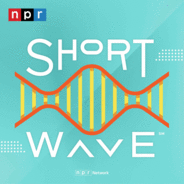Act now to ensure public media remains free and accessible to all. Your donation will help this essential American service survive and thrive. Visit donate.npr.org now.Learn more about sponsor message choices: podcastchoices.com/adchoicesNPR Privacy Policy

Wissenschaft & Technik
Short Wave Folgen
New discoveries, everyday mysteries, and the science behind the headlines — in just under 15 minutes. It's science for everyone, using a lot of creativity and a little humor. Join hosts Emily Kwong and Regina Barber for science on a different wavelength.If you're hooked, try Short Wave Plus. Your subscription supports the show and unlocks a sponsor-free feed. Learn more at plus.npr.org/shortwave
Folgen von Short Wave
1401 Folgen
-
Folge vom 18.07.2025Congress has voted to eliminate government funding for public media
-
Folge vom 18.07.2025These Scientists Are Using AI To Listen To FrogsIf you were a miner in California during the Gold Rush, you might have dined on a California red-legged frog. The largest native frog in the western United States, this Golden State denizen used to be found as far inland as the Sierra Nevada mountains and south, into Baja California. But today, they're listed as threatened under the Endangered Species Act. Conservationists have worked to translocate new populations of the red-legged frog back to California in hopes that their numbers can be restored. But how do they monitor those populations' growth? Enter AI.Want to hear more stories about critters or conservation? Let us know at shortwave@npr.org.Listen to every episode of Short Wave sponsor-free and support our work at NPR by signing up for Short Wave+ at plus.npr.org/shortwave.Learn more about sponsor message choices: podcastchoices.com/adchoicesNPR Privacy Policy
-
Folge vom 16.07.2025Who Is Using The 988 Crisis Line?The National Suicide and Crisis Lifeline — 988 — launched on this day exactly three years ago. People who call the line seeking support are connected to a local network of crisis centers and a trained crisis counselor. And while millions of people have contacted the line since its launch, a new study shows portions of the country still don't know about it. Short Wave host Emily Kwong speaks to Jonathan Purtle, one of the lead researchers of on this study, about the findings, how the hotline differs from 911 and what its existence signals to Americans. Want us to cover more mental health news? Tell us by emailing shortwave@npr.org! We'd love to know what you want to hear from us!Listen to every episode of Short Wave sponsor-free and support our work at NPR by signing up for Short Wave+ at plus.npr.org/shortwave.Learn more about sponsor message choices: podcastchoices.com/adchoicesNPR Privacy Policy
-
Folge vom 15.07.2025How Realistic Are Movie Dinosaurs?Jurassic Park: Rebirth is the latest installment in the Jurassic World series. And while dinosaur paleontologist Matt Lamanna has loved dinos — and the Jurassic Park franchise — his whole life, he says some of the films are more accurate than others. So how accurate are the ones unveiled in this latest movie? Matt gets into it with Short Wave host Regina G. Barber, who got a tour of the dinosaur exhibits where Matt works: the Carnegie Museum of Natural History in Pittsburgh. They also discuss the accuracy of the beloved giant creatures in the newest Jurassic World film, as well as some of the hits from the franchise's archive — like the dinosaur he was partially responsible for discovering. Want us to cover more natural history? Tell us by emailing shortwave@npr.org! We'd love to know what you want to hear from us.Listen to every episode of Short Wave sponsor-free and support our work at NPR by signing up for Short Wave+ at plus.npr.org/shortwave.Learn more about sponsor message choices: podcastchoices.com/adchoicesNPR Privacy Policy
